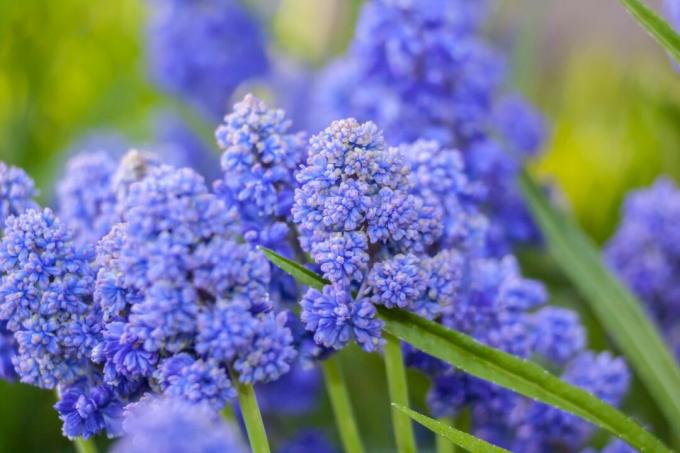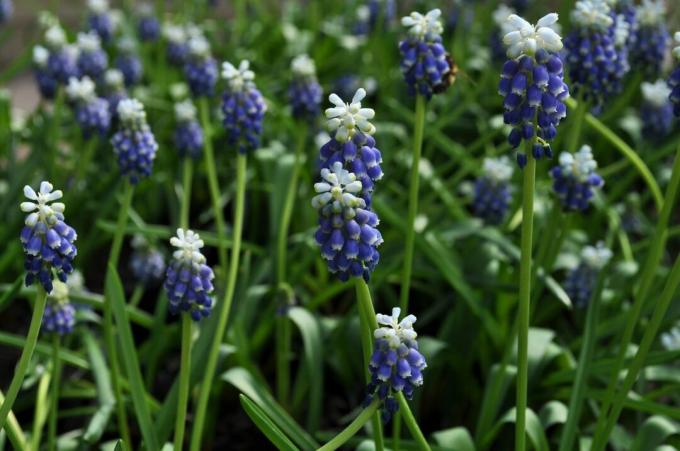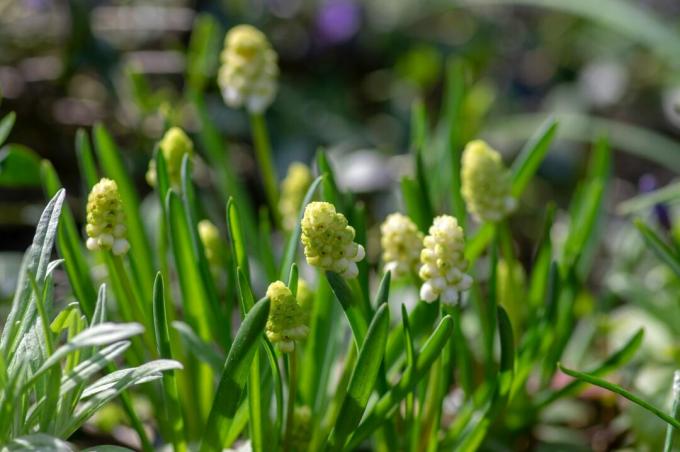Anyone who has not yet taken a closer look at the popular early bloomers will be amazed at the diversity of species and varieties that characterizes the grape hyacinth genus.

The types and varieties of grape hyacinth (Muscari) differ, among other things, in their flower shape and color, growth height and location requirements. Very popular are the Armenian grape hyacinths (Muscari armeniacum) and the small grape hyacinth (Muscari botryoides). We will present these and many more in more detail below.
contents
- Grape Hyacinth Varieties and Species: How Many Are There?
-
The most beautiful Muscari varieties and species at a glance
- Armenian grape hyacinth (Muscari armeniacum)
- Small grape hyacinth (Muscari botryoides)
- Broad-leaved grape hyacinth (Muscari latifolium)
- Grape hyacinth (Muscari neglectum)
- Tufted grape hyacinth (Leopoldia comosa; Syn. Muscari comosum)
- Aucher grape hyacinth (Muscari aucheri)
- Sky blue grape hyacinth (Pseudomuscari azureum; Syn. Muscari azureum)
Grape Hyacinth Varieties and Species: How Many Are There?
The genus Muscari comprises about 60 species, in particular some hybrid forms, i.e. forms bred by crossing different species. A large proportion of these variants occur in Turkey, but parts of Spain, Greece and other areas are also considered to be their homeland. About 10 of these species are used as ornamental plants in our gardens. There is a special selection of varieties that we present to you - the Armenian grape hyacinth in particular is very well known and convinces with a large variety of varieties.
The most beautiful Muscari varieties and species at a glance
In the following we give you an overview of which grape hyacinth species and varieties have which special features and properties. How to plant and care for grape hyacinths - you can find out more about this in our forwarding article.

Armenian grape hyacinth (Muscari armeniacum)
The Armenian grape hyacinth is a species that is naturalized in Germany and typically grows on alpine meadows, rocky slopes or on sunny woody edges. The soils at the natural sites are usually dry in the summer and only fresh in winter and spring due to the precipitation. 10 to 20 cm high clumps are formed by the formation of daughter tubers of the early summer green plant. The flowering period of this species extends from the end of March to the end of April. Muscari armeniacum suitable for planting in large groups and mass stands, but also for use in planters. This species feels noticeably well in sunny, warm locations with suitable soil and spreads quickly. Naturalization via daughter tubers and self-sowing is to be expected here in any case.
- Muscari armeniacum ˈPeppermintˈ: The buds of this strain are white at first, then develop into delicate light blue flowers with a slight white tinge, which have a firm, robust substance. ˈPeppermintˈ is particularly floriferous.

- Muscari armeniacum ˈBlue Spikeˈ: The flowers of ˈBlue Spikeˈ are medium blue in color and arranged in doubles, giving the inflorescence a pompously bloated appearance.

- Muscari armeniacum ˈSiberian Tigerˈ: This variety is a variant of the Armenian grape hyacinth with pure white flowers.

- Muscari armeniacum ˈTouch of Snowˈ: The striking bicolor of the flowers makes this variety a real eye-catcher. At the top of the inflorescence they are white and those below are mid-blue and edged with white.

Small grape hyacinth (Muscari botryoides)
The small grape hyacinth is considered endangered and in Germany can be found mainly in the Black Forest, on the Swabian Jura and in parts of the foothills of the Alps. It prefers more or less fresh soil in a full sun to partially shaded spot. In contrast to most other species, it has no daughter tubers and therefore only multiplies by self-seeding. It forms airy stands that are about 15 to 20 cm high. The odorless flowers appear from early April to early May. The small grape hyacinth is also suitable for group plantings in borders or on sunny wood edges as well as for planting in containers. This is recommended if greater spread is to be avoided.
- Muscari botryoides album: The pure white flowers of the 'Album' variety open up a wide range of possible combinations with other onion flowers that harmonize in colour.

- Muscari botryoides ˈSuperstarsˈ: The elegant flower clusters of this species are cornflower blue. Each individual flower is adorned with a pretty white ring.
Broad-leaved grape hyacinth (Muscari latifolium)
The natural habitat of the broad-leaved pigeon hyacinth is in montane vegetation zones. There the species is mainly found in sparse coniferous and mixed forests. The soils in the sunny to partially shaded locations are often dry during the summer months - fresh again in winter and spring. A clear feature that distinguishes the broad-leaved grape hyacinth from the other species is the broad shape of the one or two bluish-green leaves. It is one of the strongest grape hyacinth species and grows to a height of 15 to 25 cm. In the case of the broad-leaved grape hyacinth, propagation also takes place mainly through seeding, as it hardly ever forms daughter bulbs. The characteristic, two-tone flowers appear from early April to early May.

- Muscari latifolium ˈGrape Iceˈ: The creamy-white flower buds of this variety change color from grey-blue to blue-black and thus offer an attractive contrast.
Grape hyacinth (Muscari neglectum)
In Germany, the native specimens of the vineyard grape hyacinth are found mainly in the central and southern German warm regions. This species is also known under the names Weinbergs-Träubel and Unknown grape hyacinth. Preferred locations are generally sunny-warm or semi-shady on alkaline-rich mineral soils with little stone content and moderately dry to summer-dry conditions. Due to the propagation via daughter tubers, this species forms clumps with a height of 10 to 20 cm. Vineyard grape hyacinth flowers from mid-March to mid-April. Due to the secondary tuber formation and rich self-sowing, lawn-like stocks form at suitable locations.
Tip: The grape hyacinths like Muscari neglectum, which multiply intensively by self-sowing, can be combined with a flower meadow like the Plantura bee pasture ideal in the concept of Black box gardening be used.
- Muscari neglectum ˈBaby's Breathˈ: The enchanting flowers of this strain are pale sky blue in color with a slight gray tinge.
- Muscari neglectum ˈValerie Finnisˈ: The buds of the variety ˈValerie Finnisˈ are light sky blue and turn into bright sky blue flowers. This variety is usually the cheapest option.

Tufted grape hyacinth (Leopoldia comosa; Syn. Muscari comosum)
In the trade, the varieties of this type are often still under the outdated name Muscari comosum offered. Natural occurrence areas in Germany of the extremely warmth-loving species are, for example, in the upper Rhine plain, in the Harz foreland and the eastern Franconian Jura. The crested grape hyacinth is found on well-drained mineral soils in dry to moderately dry conditions and in full sun to part shade. Depending on the location, the plant can reach considerable heights of between 30 and 60 cm. This wild species has an unusual inflorescence, the upper part of which has an intensely violet tuft of sterile lures. In contrast, the lower part is covered with horizontally protruding, violet-blue to brownish, fertile flowers. This extravagant color phenomenon can only be admired in May.

- Leopoldia comosa ˈMonstrosumˈ: The branched flowers of this strain are all sterile and purple in color. This creates a feathery-cloudy bud in a rather artificial way.
- Leopoldia comosa ˈPlumosumˈ: The inflorescences of ˈPlumosumˈ, which appear almost extraterrestrial, also have a feathery appearance and all the violet individual flowers are sterile.

Aucher grape hyacinth (Muscari aucheri)
The Aucher grape hyacinth is mainly found on humus-poor and alkaline and lime-rich mineral soils in full sun to sunny locations. Their permeable soils are fresh to dry depending on the season. With flowers, the wild species reaches a height of 10 to 15 cm. The flowering period can last from mid-April to May. The traded varieties of the Aucher grape hyacinth are generally hybrid forms.
- Muscari aucheri ˈWhite Magicˈ: The inflorescence of this variety is pale creamy yellow in color when it buds. Later it is pure white with a creamy yellow tip.

- Muscari aucheri ˈOcean Magicˈ: The appealing variety ˈOceanMagicˈ has a turquoise-green blossoming inflorescence, which then tricolor with dark blue flowers, grey-sky blue buds and white buds at the top is occupied.

Sky blue grape hyacinth (Pseudomuscari azureum; Syn. Muscari azureum)
Also with this type the obsolete name Muscari azureum often still used. The sky-blue grape hyacinth thrives on humus-rich, not too stony soil, which is dry or fresh depending on the season. The full sun to sunny location should not be forgotten. The two to three boat-shaped leaves of the sky blue grape hyacinth are relatively wide. The bright blue hue of the inflorescences, seen from mid-March to mid-April, is a distinctive feature of this species. In addition, a blue stripe can usually be observed on the flowers. The sky blue grape hyacinth can be planted in larger groups or mass stocks, but also in planters. It has a strong tendency to go wild and thus quickly forms extensive stands.

- Pseudomuscari azureum album: The ˈAlbumˈ variety is a variant of the sky-blue grape hyacinth with pure white flowers that can be perfectly combined.
In order to gather inspiration for the right combination of these early bloomers, you can read our special article about the 10 most beautiful spring flowers to inform.
